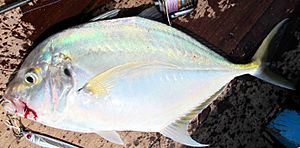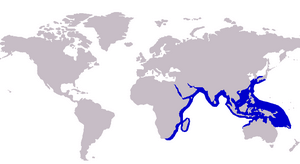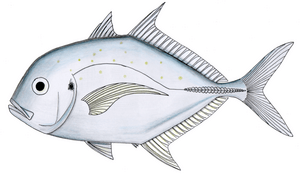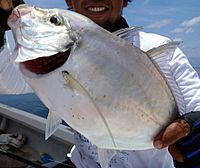Coastal trevally facts for kids
Quick facts for kids Coastal trevally |
|
|---|---|
 |
|
| Conservation status | |
| Scientific classification | |
 |
|
| Approximate range of the coastal trevally | |
| Synonyms | |
|
The coastal trevally (Carangoides coeruleopinnatus) is a type of fish that lives in the ocean. People also call it the onion trevally, Japanese trevally, or bluefin kingfish. It belongs to the Carangidae family, which includes many kinds of "jacks" and "trevallies."
This fish lives in warm, tropical waters. You can find it in the Indian Ocean and the western Pacific Ocean. Its home stretches from South Africa all the way to Japan and New Caledonia, reaching as far south as Australia. Coastal trevallies usually live around deep reefs near the coast. They can be found swimming alone or in groups. They eat small creatures that live in the water, like tiny crustaceans, small fish, and cephalopods (like squid). Fishermen sometimes catch them by accident, but they are not a very important fish for commercial fishing. However, they are known to be good to eat.
Contents
About the Coastal Trevally's Name
The coastal trevally is part of a group of fish called Carangoides. This group is part of the larger Carangidae family, which includes all the jacks and trevallies. These families are then part of an even bigger group called the Carangiformes order.
A German scientist named Eduard Rüppell first described this fish in 1830. He found a specimen in the Red Sea near Saudi Arabia. He named it Caranx coeruleopinnatus. The name coeruleopinnatus means 'blue-finned'. This is a bit strange because the fish doesn't actually have blue fins! It might have been a mistake when he wrote the name down. Because of this, you might sometimes see the name spelled incorrectly as Carangoides caeruleopinnatus in old books.
Over time, this fish was moved to different scientific groups. It also got renamed by other scientists five times! For example, in 1924, a young coastal trevally was named Caranx uii. This name became very popular, and the fish was often called the 'Japanese trevally'. But later, scientists realized it was the same fish as C. coeruleopinnatus.
Besides its scientific name, the coastal trevally has many common names. These include 'coastal kingfish', 'onion trevally', 'Japanese trevally', 'bluefin kingfish', 'shortfin kingfish', and 'diverse trevally'.
What Does the Coastal Trevally Look Like?
The coastal trevally looks a lot like other jacks. It has a body that is almost oval and quite flat from side to side. Its back is more rounded than its belly.
This fish can grow to about 40 centimeters (about 16 inches) long. However, they are usually seen around 25 centimeters (about 10 inches). It has two dorsal fins (on its back). The first dorsal fin has 8 stiff spines. The second one has 1 spine and 20 to 23 soft rays. When the fish is young, the second dorsal fin has a long, thread-like part. This part gets shorter as the fish gets older.
The anal fin (on its belly, near the tail) has 2 separate spines, then 1 spine, and then 16 to 20 soft rays. The pelvic fins (on its underside, near the head) have 1 spine and 18 to 20 soft rays. The lateral line (a special line of scales along its side) has a curved part and a straight part. The straight part has 16 to 20 tough scales called scutes.
The front part of the fish's chest, below its belly fins and up to its side fins, usually has no scales. Both its upper and lower jaws have bands of small, brush-like teeth. These teeth are wider at the front of the mouth. The fish also has 21 to 27 gill rakers, which help it filter food from the water. It has 24 vertebrae (backbones).
When alive, the coastal trevally is bluish-green on its back. This color fades to a silvery-grey on its belly. Its sides often have many small yellow spots. There's a small dark spot on the top edge of its gill cover. The fins on its back, belly, and tail are usually dark. The tail fin might be a bit yellow. Its side fins are pale yellow, and its belly fins are clear or grey. Young coastal trevallies have dark stripes that fade as they grow older.
Where Do Coastal Trevallies Live?
The coastal trevally lives in a wide area across the warm, tropical and subtropical waters of the Indian Ocean and the western Pacific Ocean.
You can find them along the east coast of Africa, from South Africa and Madagascar up to the Red Sea and the Persian Gulf. Their home also stretches east along the coast of India, including Sri Lanka. They live along the Asian coastlines, like China and Thailand, and throughout the islands of Southeast Asia and Indonesia. Their range extends south to northern Australia. In the Pacific Ocean, they live north to Taiwan and Japan, and east to islands like Tonga, Samoa, and New Caledonia.
Coastal trevallies usually don't live very close to the shore. Adult fish prefer deep reef systems along the coast. Scientists think they might also spend time swimming in the open ocean, away from the bottom. Young trevallies have been seen in estuaries (where rivers meet the sea) in Natal, South Africa, and in shallow bays in northern Australia. However, scientists don't know much about how these fish move around. Like some other jacks, coastal trevallies are attracted to floating objects. Fishermen sometimes catch them near special floating devices called FADs (fish attracting devices).
Life and Fishing
Scientists haven't studied the coastal trevally very much. This means there isn't a lot of information about its daily life and how it fits into its environment.
We know that these fish can be found alone or in small groups. They eat plankton and other small creatures that float in the middle of the water. Their diet includes tiny krill, mantis shrimp, small fish, and squid. The coastal trevally has a soft mouth and weak teeth. This means they can't catch or eat very large prey. Compared to other fish in the Carangidae family, the coastal trevally is a bit slower. We don't know anything about how they reproduce or where they travel.
The coastal trevally is not very important for most fisheries. Fishermen sometimes catch them by accident (this is called bycatch) when they are trying to catch other fish or prawns. They might be caught using hooks and lines, gill nets, or different types of traps. Because they live in deep reefs, they are not usually caught by anglers who fish for sport. Even though they are considered a good table fish, they have only a small commercial value in Asia.
See also
 In Spanish: Carangoides coeruleopinnatus para niños
In Spanish: Carangoides coeruleopinnatus para niños




